


Q 1. What is the difference between low risk and high-risk HPVs? 2. What kind of biological and epidemiological evidence would you need before you were comfortable saying that a specific virus caused cervical cancer? 3. In April of 2014, the U.S. Food and Drug Administration approved the first FDA-approved HPV DNA test for women 25 and older that can be used alone to help a health care professional assess the need for a woman to undergo additional diagnostic testing for cervical cancer. The test also can provide information about the patient’s risk for developing cervical cancer in the future. In the context of HPV pathobiology in humans, why is the recommendation after age 25? What are some of the reasons that some people oppose this test? 4. Would you support mandatory HPV vaccination for young girls in this country? Why or why not?5. List 3 reasons why breasts are vulnerable to developing cancer, and how that impacts prevention policies.
View Related Questions